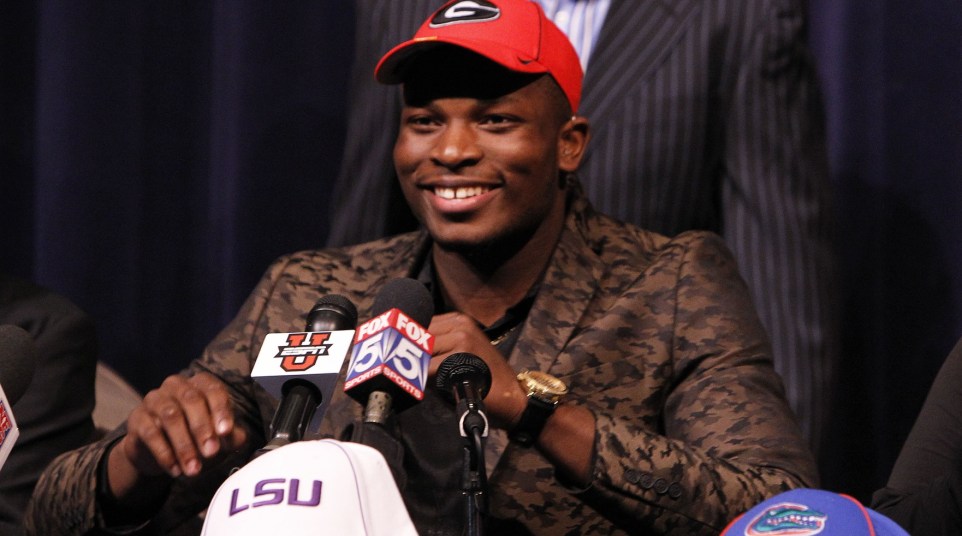Proposed early signing period wouldn't be good for business
This summer, conference commissioners will vote on whether to approve an early signing period for college athletics.
If ratified, the NCAA would open up a 72-hour window in December for high school football players to sign Letters of Intent locking them into college programs seven weeks prior to the traditional mad house that is National Signing Day.
What sounds like a fair, thoughtful, pro-athlete idea on the surface is problematic in reality.
If a well-regarded recruit decides to commit to a school in August, currently he has to wait until February to make it official. Seven fewer weeks of pestering, text messages, voicemails, tweets from opposing fans and constant bombardment at school and in public. That seems like a reasonable request for a 17- or 18-year-old kid just trying to enjoy his final days as a high schooler.
Recruiting already is a huge mess. (If I ever get married and have a son who turns out to be a four- or five-star football player — which is doubtful, because I’m a goofy-looking redhead, and that implies I’d have to find someone willing to marry me — I’m setting up a separate cell phone service, buying a burner phone, putting the battery charger under lock and key and telling him he can turn it on for a maximum of two hours per day.)
The Roquan Smith saga has illustrated a familiar and annual drama: a recruit bonds with an assistant coach and forms a relationship that’s central to the reason he’s ready to commit to a school. After signing a Letter of Intent, he learns that coach is leaving for the NFL or for another job. Only in Smith’s case, he found out Bruins defensive coordinator Jeff Ulbrich was headed to the Atlanta Falcons before faxing his binding commitment to UCLA.
Did you think Florida coach Jim McElwain’s sprint to the finish (and Will Muschamp’s Gators to Tigers redirect of several key prospects) was hectic? McElwain accepted the position on Dec. 4. If approved, the early signing period will align with the mid-year junior college date, which will be Dec. 16 in 2015.
Can you imagine the coach getting less than two weeks to recruit a top target before said player can sign with another school? Or imagine the fracas with Nick Saban or Mark Richt frantically trying to convince the kid to sign on the early day before the new Florida coach could get settled and make a late run?
How would the early signing period affect the hiring and firing of coaches? Would athletic directors feel pressure to make quick judgments with a potentially-crucial recruiting date looming in mid-December?
It’s bad enough when Ohio State running backs coach Stan Drayton waits until after signing day to announce his departure for the Chicago Bears, blindsiding signee Mike Weber. Imagine teams waiting to announce firings until after the early signing date, collecting as many binding signatures as possible, then rushing to reset with a new coach in the last seven weeks. (Talk about an entirely new meaning to “double dipping.”)
And what about coaches, operating with a limited number of available scholarships? Would they be forced to resort to grayshirting more players if, say, a touted quarterback signed with them on the early date, but they managed to woo a five-star guy at the same position during the February date in a last-minute surprise?
A 12-member study committee of conference administrators, athletic directors and former coaches recommended that the commissioners adapt the rule. They’ve obviously given careful consideration to these questions from every angle, and felt like it would be a benefit for the athletes and maybe even the teams (hard to worry about protecting against last-minute February flip if your guy signed back in December.)
But that leads us to perhaps the biggest overarching reason: college football would love to own as much of the 12-month calendar as possible.
The NFL became a multi-billion dollar business not only because of the popularity of the games from September to January. The NFL Combine in February has become a huge spectacle with mass interest. The league promotes the NFL draft as a sort of mid-year Super Bowl, pimping the run-up as much as possible and in recent years extending it into a three-day made-for-TV extravaganza.
College football has followed a similar trajectory, especially within the SEC, even if those billions are “just” tens and tens of millions. But, along with spring practice, nothing is more crucial to college football’s “offseason” than National Signing Day in early February.
The College Football Playoff semifinals already are moving to Dec. 31 for the next two years, which created a debacle at ESPN once the network realized that places two of the three most important games on a non-January weekday.
A diminished National Signing Day in February would create confusion for coaches and recruits, but it also would diminish the significance of the date, which keeps college football very relevant one month after the regular season ends.
From a pure business standpoint, it would help the game continue to grow from an interest and business standpoint if the sport found a way to create even more buzz in the time between February and the respective media days in July.
Perhaps the commissioners will ratify a December early signing window, and very few recruits will decide to sign. Perhaps it will add a layer of drama to the process in ways we have yet to understand, in turn manufacturing more interest and buzz.
But two signing periods seven weeks apart, including one in the middle of the hiring/firing season, would create a lot of issues, and the commissioners would be smart to examine each one before pushing through the proposal with a vote.

